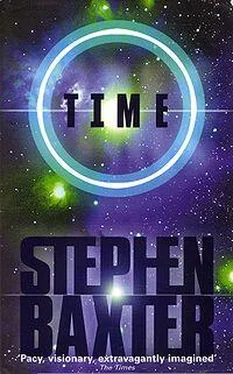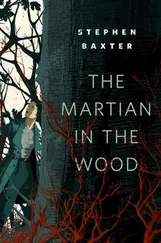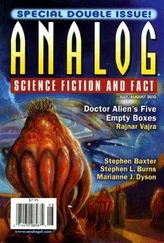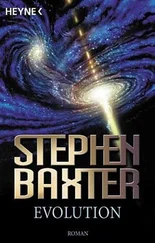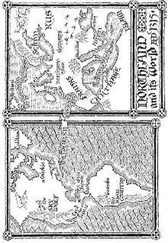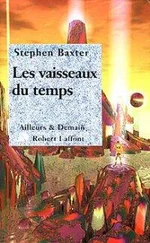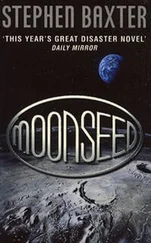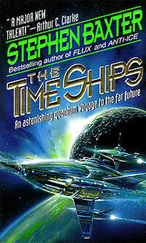The ground was coal black, layered with dust, and very uneven, extensively folded. She could see maybe a hundred yards in any direction before the ground fell away, but the horizon was close and crumpled, as if she were standing on a hilltop. The hab dome was a drab mound of regolith over orange fabric, and it was surrounded by ground that was scarred by firefly tracks. Beyond it she could see a cluster of equipment: the bulky form of the tethered O ‘Neill, and the coiling lines leading to Malenfant’s illegal nuclear power plant, now installed somewhere over the horizon of Cruithne.
And the shadows were already shifting under her feet, lengthening as she watched.
When she raised her head and looked into the sky, the sun was almost over her head, its glare steady and fierce, so that she cast only a short shadow. Off to her left she saw a point of light: blue, bright. It was Earth. But the Moon was invisible, as were the stars, washed out of her vision by the intense brightness of the sun.
Beyond sun and Earth there was nothing: above, behind, beyond her, like the depths of the deepest, darkest ocean, but spreading around her in all three dimensions. The sense of scale, of openness, after the enclosure of the ship and the hab dome, was stunning. Watching the sliding shadows, she understood on some gut level that she was indeed clinging to the outside of a rock that was tumbling in space. She swallowed hard; she absolutely did not want to throw up in a spacesuit.
A firefly robot came tumbling past, ignoring them, on some errand of its own. It was a hatbox covered with gleaming solar panels, and with miniature manipulator arms extending before it. It worked its way over the surface with a series of tethers that it fired out before itself, then winched in after it, never less loosely anchored than by two tethers at a time, and little puffs of exhaust vapour escaped from tiny kid’s-toy rocket nozzles at the rear. The firefly’s case was heavily stained with regolith; there were cute little wiper blades on each of the solar cell panels. The robot moved jerkily, knocked and dragged this way and that by its tethers and tiny rockets, but in the silence and harsh sunlight it was oddly graceful, its purposefulness undeniable.
The firefly disappeared over the close horizon. Emma wondered if it was from the O ‘Neill or the Nautilus. Ours or theirs.
She knew, in fact, that the way the firefly had gone was where the blue artifact stood in its excavated pit. A door to the future, a quarter-mile away.
The thought meant nothing. She was immersed, already, in too much strangeness.
And today, there was work to do. She turned back to the others.
e-CNN:
To recap, you are seeing pictures received live from Cruithne, broadcast from the asteroid just minutes ago. As you can see the image is a little nondescript right now, but our experts are telling us that we are seeing a stretch of Cruithne surface known as “regolith,” with the black starry sky in the background — or rather there would be stars but for overloading by the sunlight.
The slave firefly robot seems to be panning right now, under your command, and we’re trying to make out what we’re seeing. It is a little like looking for a black cat in a mine shaft, hah hah.
Just to remind you that you can take part in the live online exploration of Cruithne with the Bootstrap bandit astronauts. Just select your preference from the menu at the bottom of the picture and your vote will be polled, with all the others, once a second, and the recommendation passed straight to our camera firefly on Cruithne via our e-controller. You control the picture; you are on Cruithne right along with the astronauts; you can be a Bootstrap bandit, alongside the infamous Reid Malenfant.
Right now the image seems a little static; perhaps you folks are arguing amongst yourselves, hah hah.
There! Did you see that? Bob, can we rerun that? We can’t. Well, it looked to me like an astronaut, and it looked to me like he, or she, was waving at us. Maybe it was Reid Malenfant himself. If you folks out there want to start voting to pan back maybe we can get a good look…
Maura Della:
This was the Great Basin of Nevada.
Stretches of empty highway roller-coasted over mountain ranges and down into salt flats. The human hold on this land seemed tenuous: she drove past ghost towns, federal prisons, brothels surrounded by barbed wire. The corroded mountainsides were dominated by abandoned gold mines, and the land in between was sagebrush open range. Dust devils danced across the flats, eerie.
Eerie, yes. And, she thought, a kind of sinkhole for American national craziness too. To the south was the infamous Area 51, still a center of mystery and speculation. To the northwest, in the Black Rock desert, hippies and aging punks and other fringe meatware had gathered for decades for their Burning Man Festival, an annual orgy of gunplay, punk rock, and off-road driving.
Somehow it seemed an entirely appropriate place to site America’s largest education and protection center for the Blues — the strange, smart, alien children who had sprouted in the midst of humanity.
And Maura Della was on her way to visit little Tom Tybee there.
She stopped for gas in a place called Heston. The guy who came out to serve her was about sixty; he had a beard like Santa Claus, and a red baseball cap with the logo of a helicopter firm. The big plate glass of the gas station window was shattered; there were brutal-looking shards scattered over the forecourt.
Santa Claus saw her looking at the glass. She didn’t want to ask him how it got there, but he told her anyhow. “Sonic boom,” he said.
The thing of it was, the conspiracy theorists here had a point. If there was anywhere in the U.S. that was manipulated by remote and mysterious agencies it was Nevada, where 90 percent of the land was managed by the federal government, a remote and imperial power to the ranchers and miners who lived here. Nevada was America’s wasteland, the dumping ground for the rest of the country.
She paid, and got out of there.
At the center she was met by the principal, Andrea Reeve.
Reeve walked her around the center. It looked like … well, a grade school: flat-roofed buildings with big bright windows, a yard with climbing frames and play areas and big plastic outdoor toys, a shiny yellow fireman robot patrolling the outer walls. But most schools weren’t surrounded by an electrified fence.
Inside, the center was bright, modern, airy. The rooms weren’t set out like the formal classrooms Maura remembered, with rows of desks in the center and a teacher and a blackboard at the front. The furniture was mixed and informal, much of it soft. The walls were covered by e-paintings that cycled every couple of minutes, and other aids like number tables and giant animated alphabet letters, as well as drawings and other pieces of work by the children.
Everything was low, Maura noticed. Here was a coatrack no more than four feet from the ground, a canteen where the tables and chairs looked like they were made for dolls. The walls were mostly bare beyond the height a small child could reach.
Reeve saw her looking. “Most of our children are young,” she said. “Very few are over nine. It’s only a few years ago that the Blue phenomenon became apparent, less time since the systematic searches for the children began. We’ve brought them here from all over the continental U.S., and some from overseas. Generally rescue cases, in fact.”
Reeve looked like schoolteachers always had, Maura thought: comfortably round, a little dowdy, hair streaked with gray. Maura found herself responding instinctively, trusting the woman. But, confusingly, this motherly woman was actually about two decades younger than Maura herself. Maybe parents feel like this all the time, she thought.
Читать дальше
Конец ознакомительного отрывка
Купить книгу
